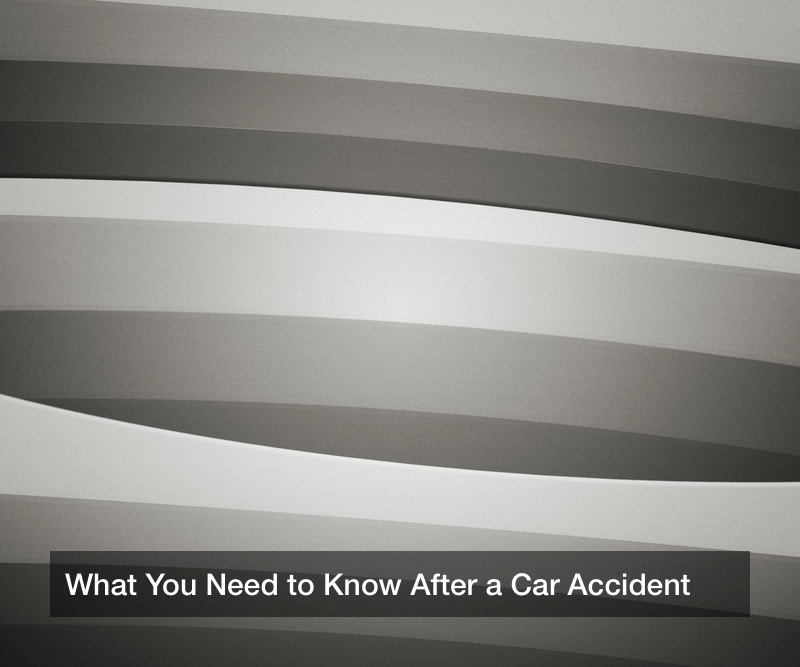
No matter where you are driving, if you chose to get behind the wheel, you run the risk of suffering an accident. The unfortunate truth of driving is that the more you drive, the more likely you are to find yourself having to deal with the repercussions of having a car accident. But what do you do when you have suffered an accident? Most drivers aren’t properly prepared to handle the events that come after an accident.
Nobody wants to think about getting into an accident, but the fact of the matter is that for most drivers it is bound to happen. Somewhere in the ballpark of 50 million people are injured in car accidents each year, so one must understand what to do in the event of such an accident. There are essentially two types of accidents, ones where you or someone else in your car is injured, and ones where there is only property damage. Both have essential procedures that must be followed in order to process insurance and receive the compensation you deserve.
Below is a basic guide for understanding what to do if you’ve been in an accident, whether there are injuries present or not. Following the basic accident guide will be the procedure to take if there are injuries present, and a guide on receiving treatment for said injuries.
Steps to Take After an Accident
STOP!!
Under no circumstances should you proceed down the roadway after an accident, regardless of how major of an accident it was. I know this seems self-explanatory, but unfortunately, it still must be said. Getting in an accident isn’t a crime, but fleeing the scene is considered a hit and run, which will more than likely result in felony charges.
Check for Injuries
This is the number one thing that must be done immediately after an accident. After an accident, check yourself and all passengers to make sure there are no injuries present that need immediate treatment. In an accident where there are no injuries present, you may move on to the next step in this procedure.
Move Your Vehicle and or Yourself to Safety
If it is possible to move your vehicle off of the roadway, proceed to the breakdown lane or the sidewalk if necessary. To prevent further accidents on the roadway, it is important to protect the scene of the accident. If it is impossible to move your vehicle from the road immediately after a car accident, then you should be prepared to set up roadside flairs, flashers, or an emergency reflective triangle. If it is impossible to move your vehicle to safety, then you must get yourself to safety with or without the vehicle.
Call the Police
I know what you’re thinking. There aren’t any injuries present, so why would we need to bring the cops into this? Unfortunately, whether or not there are any injuries to you, your passengers or anyone in the other vehicle it is smart to give the cops a call as you might need the police report to file a claim with your insurance company.
If you are not at fault, then you want to be able to get proper compensation and assistance with fixing your vehicle. Or if your vehicle is totaled, you want the police report to your insurance company can assist you when you purchase a car to replace the totaled one.
Document the Accident with Law Enforcement
Once the police have arrived on the scene of your car accident, describe to them is as much detail as possible what happened. It is important to understand what to tell the police. If there are details that you are unsure of, be open and honest with the officer about them.
If you are unsure whether or not you have sustained injuries, tell the officer that it is important to realize that some injuries sustained from an accident may present themselves after the well after the collision has occurred. Even if you feel you may need some acute lower back pain treatment or a treatment for a concussion, it is crucial if you are going to receive proper compensation for your injuries that you tell the law enforcement officer all potential injuries.
Exchange Information with the Other Driver
This step can change from state to state as far as how much information you are required to exchange with the other driver. However, starting with each other’s names and insurance information is the best place to start. If you wish to get more information to consider taking down, the make and model of the other car, a phone number for the other driver, the police report number, and the police officer’s name and badge number. If the other driver is unwilling to provide you with any of the above details, it is most important to get their insurance information and full name. The officer should also offer you a copy of the accident report, however, if they do not offer this is an important thing to ask for.
It is best to get as much information as possible from the other driver, and though it may seem like the time to discuss the actual events that occurred leading up the accident, it is best to leave that information to the police report. Revealing too much information or not understanding the gravity of what you are saying can result in you being labeled as at fault for the accident itself.
Take Photos of any Damage or injuries
With smartphones as prevalent as they are these days, there is absolutely no reason not to take pictures of any damage incurred during the accident. If you do decide to file an insurance claim after an accident, pictures of all the damage may make or break your claim. It is crucial to take these pictures at the time of the accident and with a digital time stamp that proves the date and time which you took them. Without a timestamp, the other driver could claim that the damage was done to the car during a different accident. Any injuries that you have sustained should also be photographed
Notify Your Insurance
Notify your insurance company of any and all accidents that you are in as soon as possible. Often times, insurance companies require that policyholders report accidents immediately to receive their full benefits. If you’re not sure what your insurance policy or company requires of you, it is best to play it safe and call them from the scene of the accident. Medical practices work with insurance companies to give policyholders the treatment they require, compensation from the insurance company, and medical practice loans allow physicians to take on costs that are then paid back through insurance. If you need to receive treatment through insurance, the insurance company is there to help you get what you deserve as a policyholder.
Look into Filing a Claim
After your car accident and once you’ve talked with your insurance company relaying to them all the information you have, you will want to decide whether or not to file an insurance claim. Often times, when an accident is minor, the temptation is to offer cash instead of involving the insurance companies. Settling without the help of insurance seems like the easy way out when you are at fault for a car accident, but even minimal damage can result in very costly repairs which is why you should strongly consider going through insurance and insist that the other driver does the same.
Know When to Hire an Attorney
You are not required to hire an attorney after you’ve suffered an accident, but it is important to keep in mind that having one may help you navigate the situation to the best of your advantage. Having an attorney that you trust to help you get the most out of your insurance claim can play an instrumental part in getting all that you deserve. Though insurance companies are often there to help you after a car accident, you must also keep in mind that insurance companies typically have a team of lawyers that begin reviewing your case the moment you report it. For that reason, it can often be beneficial to hire a personal injury lawyer to get the most out of your particular case.
How to Proceed if You Sustain an Injury
The above information is all incredibly useful for any car accident. Still, when it comes to receiving emergency care after sustaining an injury, even the most seasoned driver can feel up a creek without a paddle. It is important when you have sustained an injury -even a minor one- to understand the necessary treatment and how to best get that treatment.
Injuries sustained in a car accident can range from a bump or a scrape all the way to much more serious and potentially fatal. Treatment for all injuries varies depending on the type and severity of your injuries. Below is an outline of a few common types of injuries and how they should be treated.
Head Injuries
Head injuries are all too common in life, and especially common in the event of a car accident. Concussions can happen when a driver or passenger hits their head on the dashboard, the window, windshield, or any surface present in the vehicle, such as a hard cooler or a toolbox. The symptoms of concussions are often hard to notice, especially when one has suffered such an injury. Thus it is imperative to understand the symptoms and take note when you may be experiencing them.
Unfortunately, the case with concussions is such that there is little a medical professional can do to help the symptoms. However, awareness of your own body and any injuries you’ve sustained is important, so if you think you may have sustained a concussion you must seek medical treatment.
Much like head injuries, facial and dental injuries are often sustained from within the car during even the most minor of crashes. These types of injuries can be inflicted by the steering wheel or even the force of an airbag releasing. Impacts on the facial region often result in dental injuries that require orthodontic treatment and can require surgical orthodontics procedures to correct. Both child and adult orthodontics can be very pricy, so these injuries must be taken note of properly as they may be covered by your or the other driver’s insurance. Luckily, surgical orthodontics aren’t always needed.
Internal Injuries
The impact of an accident can often produce injuries to your internal organs. Internal injuries often present themselves slowly. Thus it is important to seek medical treatment if there is any chance you might have sustained such an injury. An incorrectly worn seatbelt or the impact of an airbag can cause internal bleeding, which may lead to serious and sometimes fatal complications.
Neck, Back, and Spine Injuries
If your vehicle is hit from the rear or the side, you will likely suffer from a neck or spine injury such as whiplash. Neck injuries vary dramatically in their severity and can sometimes even require surgery. However, most cases of whiplash can be treated with over-the-counter pain relievers.
Psychological Injuries
Many people underestimate the mental toll that a car accident can have on even the most veteran driver. Severe accidents often induce crippling anxiety, which requires psychological treatment to work through. Don’t forget that even mental injuries are often covered by insurance, and if you require psychological help you can work with your insurance company to get the help that your mind requires.
Take Away
Making it out of any car accident feels like an escape from disaster, but it is important not to forget that there is a procedure that must be followed to get all that you are entitled to in the event of a crash. Always drive safely and according to road conditions, wear your seatbelt, and keep your eyes on the road. However, when all of that doesn’t work, and you find yourself in an accident, keep in mind the above information to keep you and you passengers as safe and as insured as possible.







